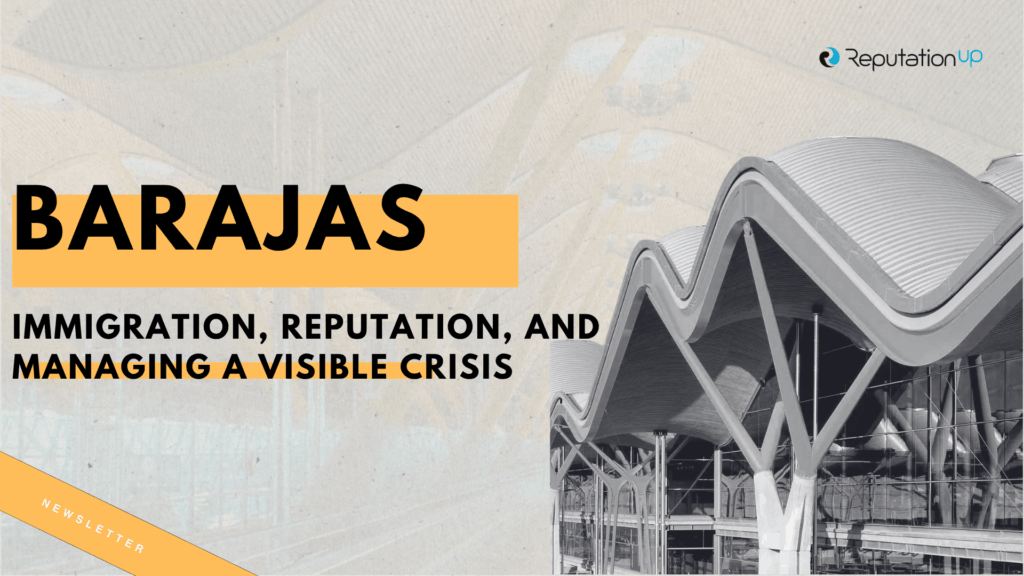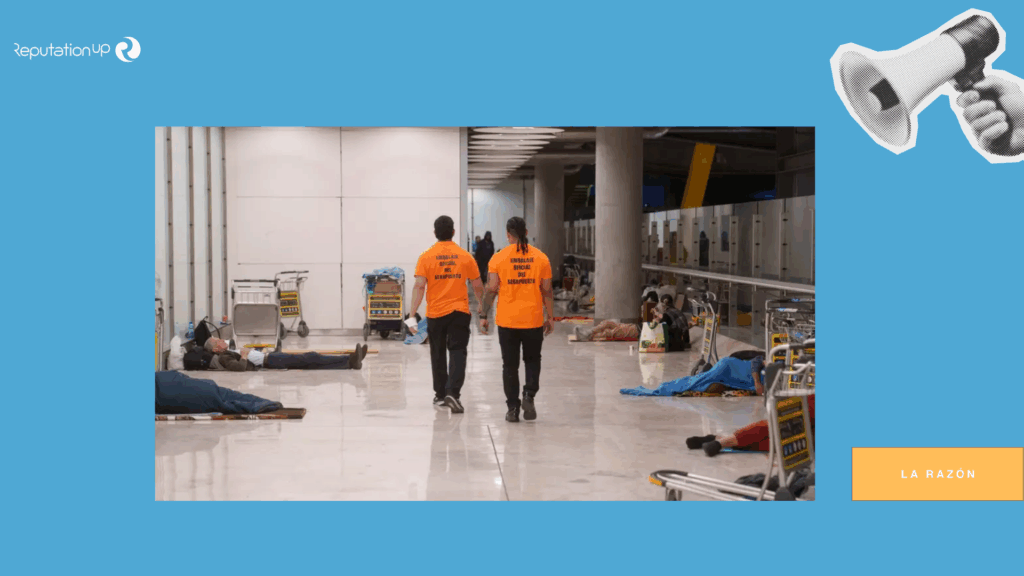Adolfo Suárez Madrid-Barajas Airport is not only a key infrastructure for international transit: it has become an unexpected reputational epicenter, where the challenges of migration management, institutional communication, and global public perception converge.
In recent weeks, Barajas Airport has made headlines in national and international media not only for its air traffic, but for something much more serious: dozens of homeless migrants of sub-Saharan origin sleeping on cardboard boxes near Terminal 1.

This is not a new phenomenon, but it is one of unprecedented visibility. Images captured by journalists, associations, and citizens have multiplied their impact on social media, generating a reputational crisis for several institutions simultaneously: AENA, the Spanish government, the embassies involved, and humanitarian aid services .
According to recent data published by La Razón, only 14 of the more than 100 migrants detected in recent weeks have agreed to be transferred to shelters.
Most, in an irregular situation, refuse for fear of being expelled, thus losing access to the asylum process.

Humanitarian crisis or reputational crisis?
From an operational perspective, security forces, municipal services, and organizations like the Red Cross have activated response protocols. But from a reputational perspective, the situation poses even greater challenges:
- International tourists photographing makeshift camps.
- Digital conversations with peaks of negativity towards the country’s image.
- Cross accusations between administrations regarding management responsibility.

These types of situations trigger what we at ReputationUP call a multi-channel reputational crisis , where the origin of the problem may be external, but the impact is reflected in the public perception of various actors.
In this case, AENA , as the manager of Barajas Airport, is directly involved, even though the factors exceed its jurisdiction. The same applies to the Ministries of the Interior, Inclusion, and Foreign Affairs, as well as local governments.
In situations like this, the real risk is not just what happens, but what is perceived to happen.
In this type of scenarios, a key tool is the Reputational risk analysis, which allows for the detection of critical points, actors involved, and emerging narratives before the problem escalates.
Visible migration: when urgency sets in at an international hub
Barajas is one of the five busiest airports in Europe. In 2023, it handled more than 60 million passengers . Its image is not only that of a gateway to Spain: it is also the first impression of the country for thousands of travelers every day.
The fact that homeless people remain for weeks in the airport’s public area—without sanitation, ongoing medical care, or safe space—not only represents a humanitarian challenge, but also a high-impact reputational risk:
- It could affect Spain’s image in international rankings.
- It can fuel polarized political discourse at the European level.
- It can project a lack of coordination or protocols to the global public.

In this context, proper management requires more than operational attention : it demands active monitoring of the public narrative. Media, networks, and perception must be managed in real time with tools like the RepUP Monitoring Tool.
Whose reputation is it in a shared crisis?
In these types of episodes, institutional online reputation is not fragmented according to legal jurisdiction . Citizens, the media, and the international community make no distinction between ministries, agencies, or public companies. The perception is uniform.
For this reason, episodes like the one in Barajas generate transversal impacts:
- AENA , due to the state of the airport.
- Central government , for migration management.
- Local government , for the humanitarian response.
- Embassies of countries of origin , due to the lack of consular collaboration.
None of these institutions alone created the problem. But all are perceived as part of the responsible environment. And, therefore, all are affected.
In this type of situations, the use of Customized Google Alerts and reputational dashboards allow you to react to spikes in negative exposure across search engines, social media, and the media.

European comparisons: How do other countries do it?
at airports such as Paris-Charles de Gaulle , Frankfurt , and Fiumicino (Rome) . The difference isn’t always the absence of the problem, but rather the media and communications management:
- Italy , for example, has centralized statements on migration in a single spokesperson.
- Germany has strengthened coordination between the Federal Police and social services with protocols visible to passengers.
- France uses internal information screens to provide a preemptive overview of available services.
These strategies do not eliminate the problem, but they mitigate its reputational impact by showing that the State has control, even in the face of complex phenomena.
What if the problem doesn’t go away?
One of the keys to the Online reputation analysis means assuming that not all problems can be resolved immediately . But they can be managed through narrative:
- Recognize the problem institutionally.
- Communicate the actions being taken, even if they are partial.
- Show data and figures that explain the complexity.
- Coordinate messages from a single voice.
In this case, the lack of a unified official narrative has left the public space open to interpretation: some well-intentioned, others misinformed or politicized, causing obvious reputational damage.
Barajas as a reputational mirror
What’s happening today at Barajas Airport isn’t just an urban anecdote. It’s a case study of how managing a visible crisis can affect the digital reputation of various actors , even if they aren’t the direct cause.
It’s also a warning about the need to anticipate, listen, and act before events go viral.
At ReputationUP, we insist that crisis management is no longer a luxury reserved for large companies. Any public institution, critical infrastructure, or government entity needs crisis protocols. Crisis management adapted to the digital environment.
And now what?
In the coming days, media attention on Barajas may diminish. But the images will remain on the internet. And the search results will remain if no action is taken to restore the perception.
Reputation isn’t erased by silence. It’s rebuilt with strategy, coordination, and transparency.
Spain faces an opportunity: to turn a visible crisis into a demonstration of institutional responsibility. To achieve this, it’s not enough to simply manage the airport. We must also manage the narrative.
What do you think? Should the reputation of public institutions depend on facts, perceptions, or both?

